In the past 50 years since CCOF’s founding in 1973, research about organic has come a long way. We now know that the benefits of organic our founding members believed in so fiercely are backed by scientific data to have a measurable effect on the wellbeing of our planet, communities, and economy.
Interested in digging deeper into the research on organic? Read our Roadmap to an Organic California: Benefits Report for more details and a robust list of references so you can explore the science yourself.
Will you join us in choosing organic and supporting the multifaceted benefits it offers our world? Here are 50 reasons to choose organic every time you visit the farmers’ market or grocery store.

1. Organic practices protect bees.
Organic farms provide food and nesting sites for pollinators, including honeybees whose pollination services are valued at $15 billion per year in the United States and $190 billion worldwide because of their irreplaceable role in global food security. Organic farms are also prohibited from using pesticides that are toxic to bees.
One of the biggest threats to bees is neonicotinoid pesticides, which harm the nervous systems of insects, including bees. When bees are exposed to neonicotinoids, it affects their ability to find food, grow, reproduce, and move, leading to weaker bee colonies. Organic prohibits the use of synthetic pesticides like neonicotinoids, which prevents bees from being exposed to the toxic chemicals present in the pollen and nectar of crops grown using pesticides or pesticide-treated seeds.

2. Organic prioritizes animal welfare.
Organic farmers must provide animals with 100% organic feed and safe, clean, cage-free living conditions. In addition, organic animals must have access to the outdoors and the ability to roam freely. Organic even requires that cows graze on rich, nutritious grass for a minimum of one third of their lives.

3. Organic creates business opportunities.
Organic is the fastest growing sector of the U.S. food industry. Organic grew 4% in 2022, well above the 1.6% growth in all U.S. food sales. Today, organic is a nearly $68 billion sector. Over 82% of families in the United States buy organic foods. Walmart, Costco, Target, Kroger, Safeway, and other national grocery chains make organic products available and affordable to a broad range of consumers. All along the supply chain, growing demand for organic provides business opportunities for both new and established operations.

4. Organic provides better living conditions for farmworkers and their families.
Organic provides family stability for farmworkers by providing year-round employment and higher wages. It also protects farmworkers and their families from routine exposure to synthetic pesticides.
Year-round employment on organic farms also improves educational opportunities for farmworker families. A secure job in one place provides the basis for a safe and stable family life and allows their children to receive an education without constant interruption from moving to find additional work opportunities in other areas.

5. Organic meat and dairy mitigate climate change.
Organic livestock production sequesters carbon through grazing practices. Organic standards require ranchers to graze livestock on organic pasture for at least 120 days per year. Studies show that grazing leads to sequestration of carbon in the soil, particularly under grazing systems that allow animals to graze for precise amounts of time in small pastures.

6. Organic prevents antibiotic resistance.
Organic meat and milk production meets the demand for these products without contributing to the global antibiotic resistance crisis because organic livestock cannot be treated with antibiotics. In addition, organic ranchers have restricted use of 22 synthetic drugs compared to over 550 used in conventional livestock production. Organic meats are also less likely to be contaminated by antibiotic resistant bacteria than non-organic meat products.

7. Organic is non-GMO and more.
The use of GMOs is prohibited in organic production, AND organic supports a food system that values environmental stewardship, public health, animal welfare, transparent labels, and traceability of products without the use of toxic fertilizers or pesticides. Genetic engineering is prohibited in organic food and farming because of concerns about their environmental and health repercussions. Studies indicate that GMOs can disrupt the ecosystem, damage vulnerable wild plant and animal populations, and harm biodiversity.
In addition to not using GMOs, organic producers promote and enhance biodiversity, biological cycles, and soil fertility, and restore, maintain, and enhance ecological harmony.

8. Organic protects public health.
Organic protects public health in both rural and urban communities. Organic reduces the amount of harmful synthetic pesticides, antibiotics, and hormones that we might be exposed to through the environment or the food we eat. Organic also promotes health by producing fruits and vegetables high in nutrients like antioxidants, as well as meat and dairy with beneficial fatty acid profiles.

9. Organic practices reduce erosion.
Soil erosion is a serious threat to food production that organic agriculture prevents. By 2030, widespread soil degradation could endanger food security and, if no action is taken, the United States could run out of topsoil before the end of this century. Organic farms are required to use a crop rotation specifically to reduce soil erosion. By increasing the diversity of crops grown in a rotation, organic farmers increase soil organic matter level, which creates good soil structure that absorbs water and prevents soil from blowing or washing away.

10. Organic follows every step of the food supply chain.
Before an organic product makes it to the shelves, its journey from seed to package is followed closely to verify that it is organic.
The first link in the chain is the land on which the product is grown. Then, the operation growing the product, the post-harvest facilities preparing it, and the processing and handling facilities transforming it – each link in the chain must be certified to the federal organic standards and go through annual reviews and inspections. This way, consumers can trust that what’s certified organic is truly organic.

11. Organic stimulates the economy.
Agricultural economists have found lower county poverty rates and higher median household incomes in California counties with high levels of organic activity. Additionally, organic farms are far more likely to sell their products locally than non-organic farms. Farms that sell locally buy most of their supplies and services from nearby businesses and hire more local workers. This means money stays within the community and creates more jobs for people in the area.

12. Organic milk and meat contain beneficial fatty acids.
Recent studies show that organic meat and dairy have healthier fat profiles than non-organic meat and dairy because of the animals’ grazing and forage-based diet required by national organic rules.
Organic milk and meat research finds that organic milk has a more beneficial fatty acid composition than conventional milk, and higher levels of polyunsaturated fatty acids. These fatty acids provide health benefits including lowering cholesterol and reducing the risk of cardiovascular events cardiovascular-related deaths.

13. Organic protects pollinators.
Did you know that 75% of fruit, vegetable, and nut crops depend on pollinators? Organic farms help pollinators by growing a diversity of crops and permanent hedgerows. These hedgerows create a safe place for pollinators to live and provide a constant food source. This is important because pollinators are rapidly losing food and nesting resources. Evidence shows that organic farms increase pollinator abundance and safeguard these precious creatures that humans rely on to pollinate the crops that are consumed at almost every meal.

14. Organic helps protect children at school.
A California Department of Public Health study in pesticide-heavy California counties found that children in 36% of schools in these counties were exposed to harmful pesticides. These pesticides contain harmful substances that can cause cancer and harm development. Farming organically close to schools is one solution to this ongoing challenge because organic bans synthetic pesticides.

15. Organic standards are developed through a citizen advisory group.
The National Organic Standards Board (NOSB) is a Federal Advisory Committee that advises the USDA Secretary of Agriculture on which substances should be allowed or prohibited in organic farming and processing and other issues in organic certification. This 15-member volunteer citizen advisory board is designed to ensure that a diversity of perspectives is considered before final recommendations are presented to the Secretary of Agriculture. NOSB is made up of four farmers, two handlers/processors, one retailer, one scientist, three consumer/public-interest advocates, three environmentalists, and a certifying agent.

16. Organic farms are regenerative and more.
While the definition of “regenerative” is still debated, in general it’s accepted to describe agricultural practices that improves natural resources, improves soil health, and creates farm systems that align with ecosystems and improve quality of life for native plants, pests, and animals. Organic standards do all that, and more.

17. Organic food is highly nutritious.
Organic crops, milk, and meat are rich in vitamins, minerals, and antioxidants, as well as significantly lower levels of pesticide residues. Organic processed foods must be made with organic ingredients and use fewer than 100 processing aids and additives, compared to over 3,000 permitted in nonorganic food.

18. Organic raises median household incomes.
Agricultural economists have found that organic hotspots—counties with high levels of organic agricultural activity whose neighboring counties also have high organic activity—raise median household income by over $1,600. Another study of USDA data finds that areas with clusters of organic businesses have $9,000 higher median incomes.

19. Organic creates a sustainable global food supply.
Organic soil-building and biodiversity practices create farms that are resilient to extreme weather conditions such as drought and hurricanes. Worldwide studies show that farms using organic practices experience fewer losses of crops, topsoil, and money after extreme weather events compared to non-organic farms.
Comprehensive studies show that organic agriculture can feed 9 billion people by 2050 while protecting the environment at the same time. Organic minimizes environmental harms associated with other agricultural systems such as loss of biodiversity, soil erosion, and water contamination.

20. Organic protects expectant mothers from harmful pesticide exposure.
CW: pregnancy and birth complications.
The most routine pesticide exposure occurs off the field when farmworker families are exposed to pesticides that enter their homes and communities. Pesticide exposure starts early for children, who are even exposed in the womb. One two-decade study found that when pregnant mothers are exposed to certain pesticides, it can lead to problems with how their children’s brains develop, lower IQ, and trouble paying attention. California mothers living near places where specific synthetic pesticides are used have a higher chance of having a child with autism spectrum disorder. Organic farms ban the use of synthetic pesticides, which protects both mothers and their children.
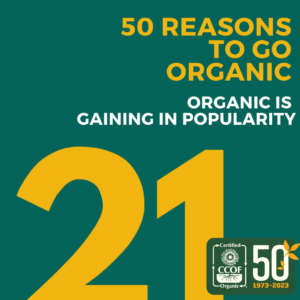
21. Organic is gaining in popularity.
According to the U.S. Census data and Simmons National Consumer Survey (NHCS), 94.38 million Americans used organic foods in 2020. The same year, organic food sales in the United States soared past $60 billion for the first time. According to the Organic Trade Association’s 2023 Organic Industry Survey, organic sales – including organic non-food products, are now at a record $67.6 billion and growing.

22. Organic reduces exposure to hormones.
Unlike organic livestock, non-organic livestock may be treated with added hormones to increase production. These hormones can contaminate both animal tissues and the water running off the farm. In humans, hormones support growth, development, and biological processes such as puberty. According to the President’s Cancer Panel, scientists suspect that synthetic hormones interfere with human hormonal systems (endocrine disruption), so they recommended that Americans switch to an organic diet to reduce hormone exposure.

23. Organic conserves water.
Organic conserves water resources by building soils high in organic matter that can better absorb and store water. In a 4-year trial in Nebraska, organic plots had 30-50% greater soil aggregation and ten times higher water infiltration than non-organic plots. The findings of numerous studies show that organic soils can better use rainwater by absorbing and storing higher amounts of water in the soil, which means there is more water available for plants during dry weather.

24. Organic provides healthier work environments for farmworkers.
Organic provides better working conditions for farmworkers and farmworker families through year-round employment and protection from routine exposure to synthetic pesticides in the fields and at home. Organic farms are also more likely to provide farmworkers with full-time, year-round employment with better wage opportunities.
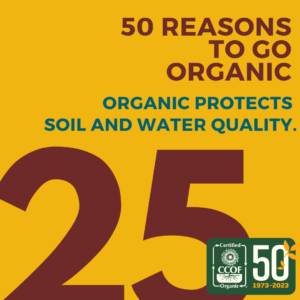
25. Organic enhances the land’s long-term agricultural productivity.
Organic practices improve soil quality and structure, which reduces topsoil erosion and enhances long-term agricultural productivity. Also, because organic soil can hold more water and synthetic pesticides and herbicides are banned in organic, it helps stop these harmful chemicals from getting into the water and polluting it.

26. Organic helps new farmers’ businesses succeed.
Research shows that demand for organic products is growing, and organic crop and livestock products’ prices contribute to farm profitability. Farmers have business opportunities to increase domestic organic farm sales to meet U.S. demand for organic products. The United States is the largest organic market in the world, and in 2016 the United States imported $1.65 billion of foreign organic products, some of which were crops and products commonly produced in the United States.
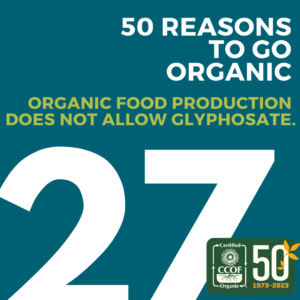
27. Organic food production does not allow glyphosate.
In 2015, the International Agency for Research on Cancer (IARC) classified glyphosate as “probably carcinogenic to humans.” The National Organic Program does not allow prohibited substances such as glyphosate in organic food production.

28. Organic creates jobs.
Organic creates an estimated 1.9 million jobs in the United States and 1.2 million jobs in California. Forty-two percent of organic businesses increased employment in 2017, creating a variety of jobs, from farm work and food production to positions with national retailers and certifying agencies.
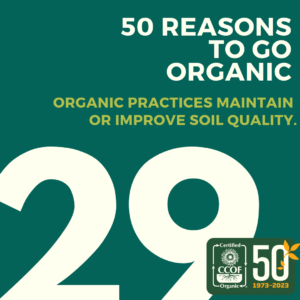
29. Organic practices maintain or improve soil quality.
Organic farms are required to meet specific soil quality standards set by the National Organic Program. These farms must implement tillage and cultivation practices that maintain or improve the physical, chemical, and biological condition of the soil and minimize soil erosion. They must also maintain or improve soil organic matter content and avoid contamination of soil by fertilizers and other inputs.
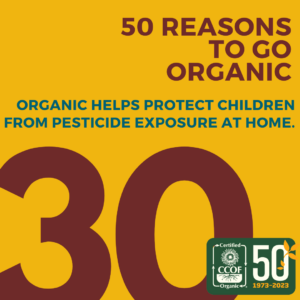
30. Organic helps protect children from pesticide exposure at home.
Pesticide levels in carpet dust contribute to higher leukemia rates in children living on or near conventional farms. These pesticides contain harmful substances that can cause cancer and harm development.
Given the health risks associated with synthetic pesticides, organic agriculture is an important alternative approach for protecting farmworkers and their families.
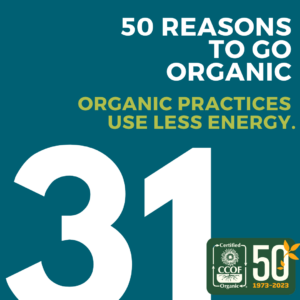
31. Organic practices use less energy.
Organic farms usually use less energy for their farming needs compared to non-organic farms. This is because they aren’t allowed to use synthetic pesticides and fertilizers that rely heavily on fossil fuels. In the United States, about 40% of energy used to produce crops and livestock is used to manufacture synthetic fertilizers and pesticides. In contrast, organic farms use inputs that require less energy to produce such as composts, animal manures, and cover crops.
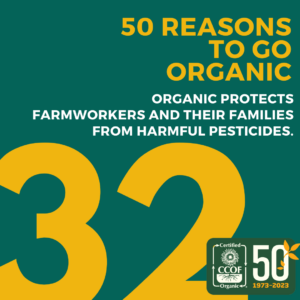
32. Organic protects farmworkers from harmful pesticides.
Organic farms create workplaces that protect farmers and farmworkers because they don’t use harmful synthetic pesticides that can cause serious health problems like cancer, brain diseases, and breathing issues. Farmworkers on organic farms avoid these risks and stay healthier while doing their jobs.
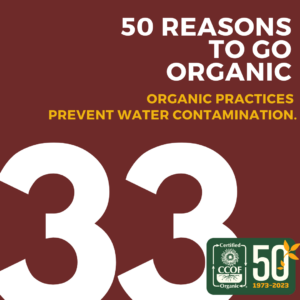
33. Organic practices prevent water contamination.
Organic protects water quality by not using synthetic pesticides or fertilizers. Additionally, organic management improves soil structure to better retain water and nutrients, and as a result, reduces leaching of fertilizers and pesticides into waterways.

34. Organic practices sequester carbon.
Organic farms have high levels of soil organic matter (SOM). With high levels of SOM, soils can store (sequester) large amounts of carbon, which reduces levels of the greenhouse gas carbon dioxide (CO2) in the atmosphere. Plants draw CO2 from the atmosphere and combine it with water via photosynthesis to create the nutrients needed for plant growth as well as the oxygen we breathe. Carbon from the plants is stored in the soil when organic farmers incorporate crop residues. Studies have shown that after 10 years, organic systems resulted in 14 times the rate of carbon sequestration than non-organic soils. Numerous other studies have also demonstrated the power of organic practices to sequester carbon at high rates.

35. Organic provides year-round employment for farmworkers.
Organic farms tend to create more full-time, year-round employment opportunities for farmworkers, which increases wage security and family life stability for workers and their families. This is because organic farming methods require more labor to manage weeds, insects, pests, and disease. Organic farmers also tend to grow a higher diversity of crops, which requires more skilled labor than managing a single row crop. This results in more sustained labor needs on organic farms.
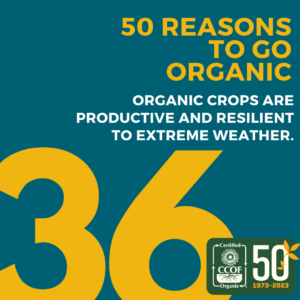
36. Organic crops are productive and resilient to extreme weather.
Organic farms are more resilient to extreme weather conditions such as drought or hurricanes because they support healthy soils and maintain robust levels of biodiversity. Organic soils maintain good soil structure under rain or wind, preventing topsoil and nutrients from washing away during heavy rains. Farm biodiversity also helps farms be more resilient by supporting diverse species that can handle various environmental shocks.
A Rodale Institute study found that organic fields produced more corn and soy during droughts because they kept more water in the soil. Additional studies have found that organic and diversified farms fare better after hurricanes because they had fewer crop losses and retained more topsoil.
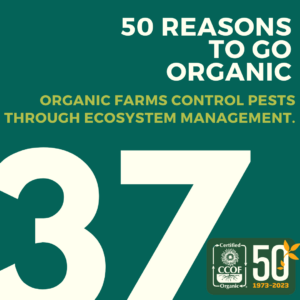
37. Organic farms control pests through ecosystem management.
Organic farmers use strategies like crop rotation, cover crops, and dense planting to enrich their soil, instead of using toxic pesticides and herbicides. Doing so increases biodiversity and decreases the farm’s impact on the environment. It also enriches soil on the farm, which nurtures the plants and prevents plant disease. Beneficial insects and animals are encouraged to thrive, so they end up controlling harmful pests through natural ecosystem functions.
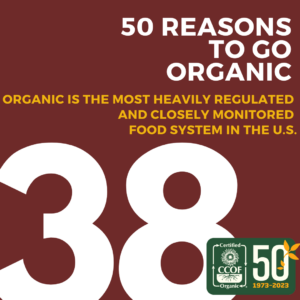
38. Organic is the most heavily regulated and closely monitored food system in the U.S.
The organic label is backed by a set of strict government regulations. The standards make it possible to trace products from farm to table, meaning you can trust the organic products you buy.
Becoming certified organic is a rigorous, multi-step process. Companies must submit detailed information about their business, the nature of their operation, the production/handling processes they use, and the products they produce. Third-party inspectors conduct both announced and unannounced inspections of organic businesses to verify that they are following organic rules.
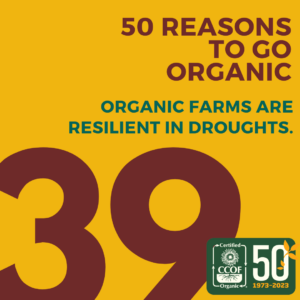
39. Organic farms are resilient during droughts.
Organic soil management creates soil that stores water that crops can use during periods of drought. For example, during five years of drought in the Northeast, organic corn yields were 28-35% higher and organic soybean yields were up to 50% higher than conventional yields. When the drought was followed by extreme rainfall, organic fields captured twice as much water as conventional fields and produced 38-137% higher organic corn yields and 152-196% higher organic soybean yields than conventional fields.

40. Organic reduces poverty rates.
Agricultural economists have found that organic hotspots — counties with high levels of organic agricultural activity whose neighboring counties also have high organic activity — lower county poverty rates by as much as 1.6 percentage points. Another study of USDA data finds that areas with clusters of organic businesses have 4% lower county poverty rates.
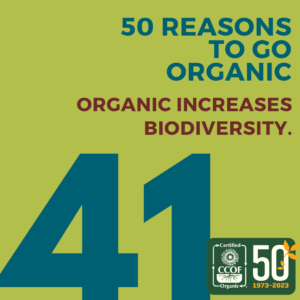
41. Organic increases biodiversity.
Agriculture is one of the biggest drivers of biodiversity loss worldwide. Fostering robust populations of diverse plants, animals, insects, and soil-dwelling organisms is a fundamental principle of organic production because organic farmers are required to implement practices that maintain or improve biodiversity on their farms. Studies show that organic farming increases biodiversity by 30% compared to non-organic farming.
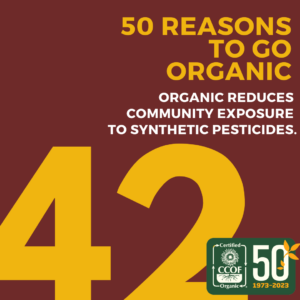
42. Organic reduces community exposure to synthetic pesticides.
Organic agriculture protects nearby rural and urban communities from exposure to synthetic pesticides that may persist in the air, water, and soil. People who live in agriculture-intensive regions of California are at 69 times the risk of poisoning from exposure to pesticide drift than other regions. Children have a higher risk of exposure to these pesticides because they play outside and on the ground. Being exposed to these pesticides can cause cognitive problems, lower memory and intelligence, impaired brain development, and increased risk of diabetes and asthma. By prohibiting use of these pesticides, organic agriculture plays an important role in protecting communities from harmful exposures.
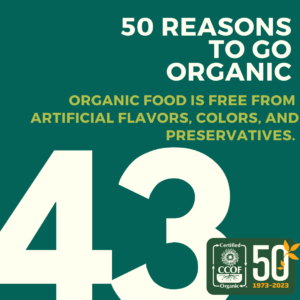
43. Organic food is free from artificial flavors, colors, and preservatives.
Organic food products are not allowed to include artificial flavors, colors, and preservatives. Minor non-organic ingredients used in processed organic food must come from a list of approved substances that have been evaluated for safety and their impact on both human and environmental health. By law, these ingredients must make up 5% or less of total ingredients to make organic food.

44. Organic mitigates climate change.
Organic mitigates climate change through practices that sequester carbon, lower energy usage, and reduce emissions.
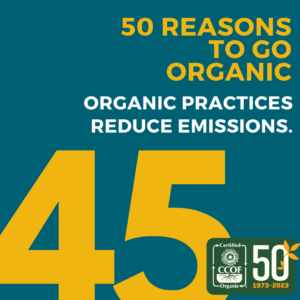
45. Organic practices reduce emissions.
Increasing to 10% organic acreage would reduce emissions equivalent to 601,500 cars per year. Going fully organic would be the equivalent of removing 7.8 million cars from the road!
A study at UC Davis compared organic and non-organic plots over 13 years. The organic plots stored 131% and 135% more carbon dioxide equivalents compared to the non-organic plots, which actually released greenhouse gases. Numerous other studies back up these findings.
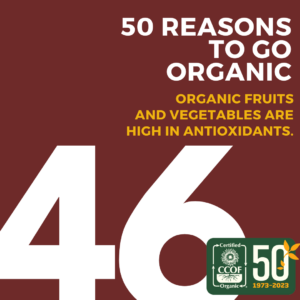
46. Organic fruits and vegetables are high in antioxidants.
An individual switching to an organic diet from a non-organic diet would intake 20-40% more antioxidants, or the amount gained in one to two extra portions of fruits and vegetables, without increasing caloric intake. Higher antioxidant concentrations are especially significant because they are linked to reduced risk of chronic diseases, including cardiovascular disease, neurodegenerative diseases, and certain cancers.
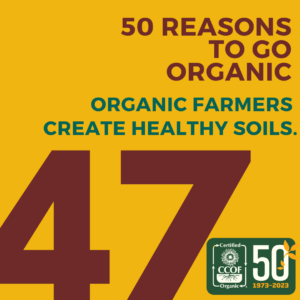
47. Organic farmers create healthy soils.
Evidence from long-term comparison trials across the United States shows that organic practices significantly increase a major indicator of soil health, soil organic matter (SOM). SOM is a complex of living microbes and decomposing plant and animal materials. SOM provides a host of environmental benefits. It builds long-term soil fertility, reduces pollution from soil erosion and nutrient runoff, absorbs and stores more water and nutrients, holds carbon in the soil, and improves soil structure.
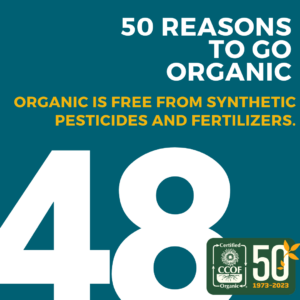
48. Organic is free from synthetic pesticides and fertilizers.
Organic production does not allow harmful synthetic pesticides or herbicides. A synthetic pesticide or herbicide is a substance that is formulated or manufactured by a chemical process to destroy or repel pests or weeds. Chemical pesticides and herbicides have been linked to birth defects, obesity, diabetes, ADHD, and other health problems. Each time you choose organic, you are choosing to leave these chemicals off your plate.
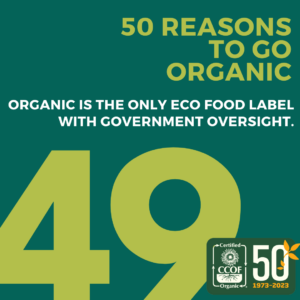
49. Organic is the only eco food label with government oversight.
Food companies can use the terms “natural,” “sustainable,” “no-spray,” and others on their labels whenever they want to, whether or not they actually follow these practices. “Organic,” on the other hand, is a term regulated by the federal government, and it is against the law to label a product as organic if it is not verified to follow the organic regulations.
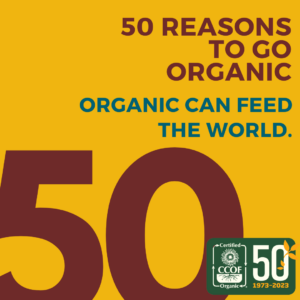
50. Organic can feed the world.
Studies on farms have found that organic crops like fruits, vegetables, grains, and forage can provide similar or even better yields compared to non-organic crops. Numerous studies conclude that with increased organic research and grower education, organic agriculture can produce highly competitive yields.